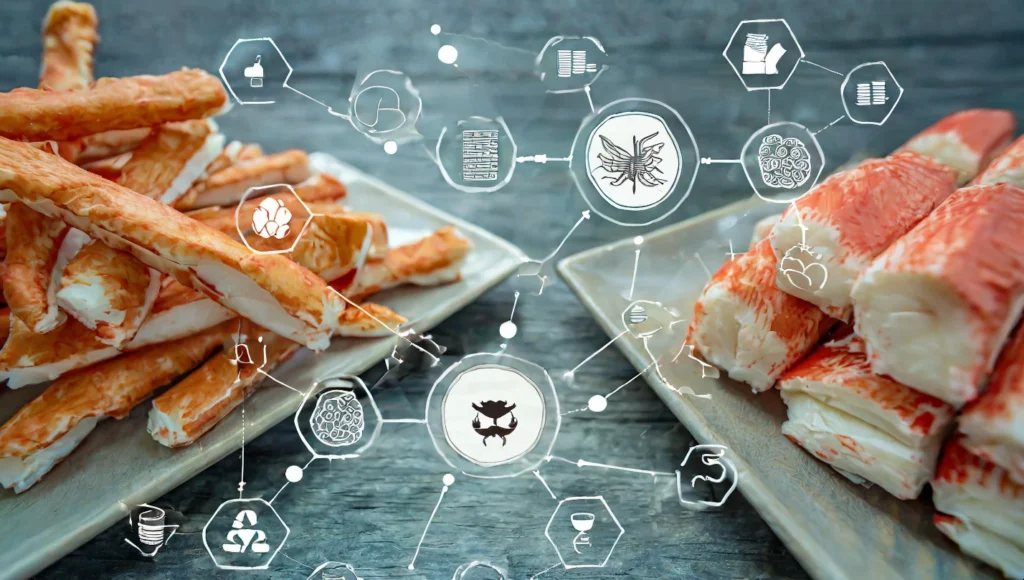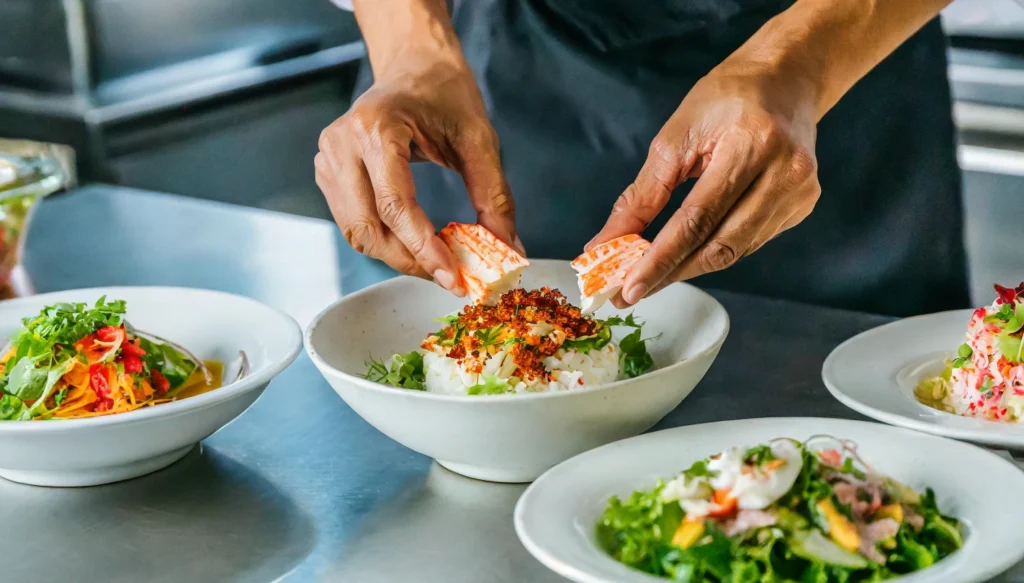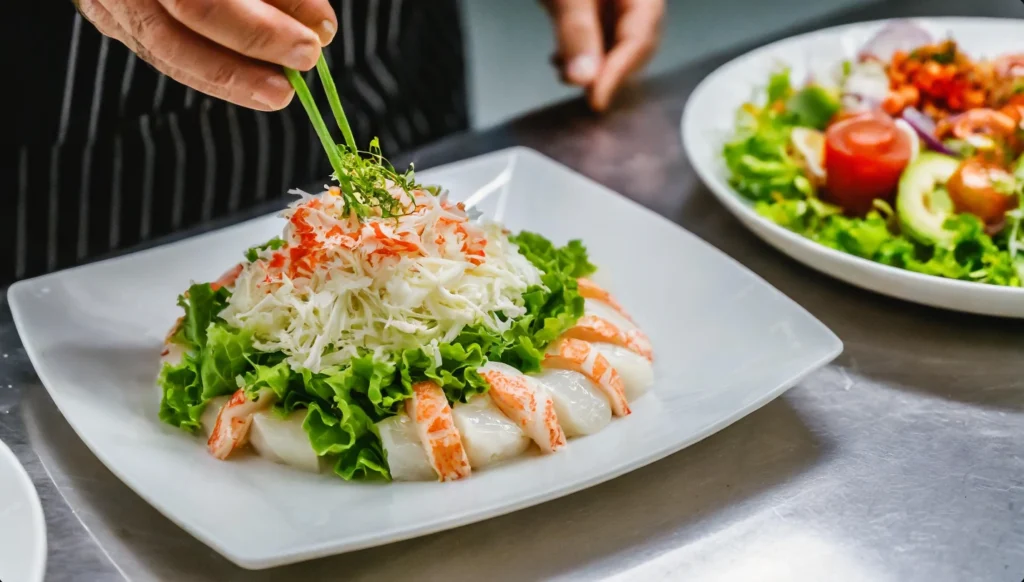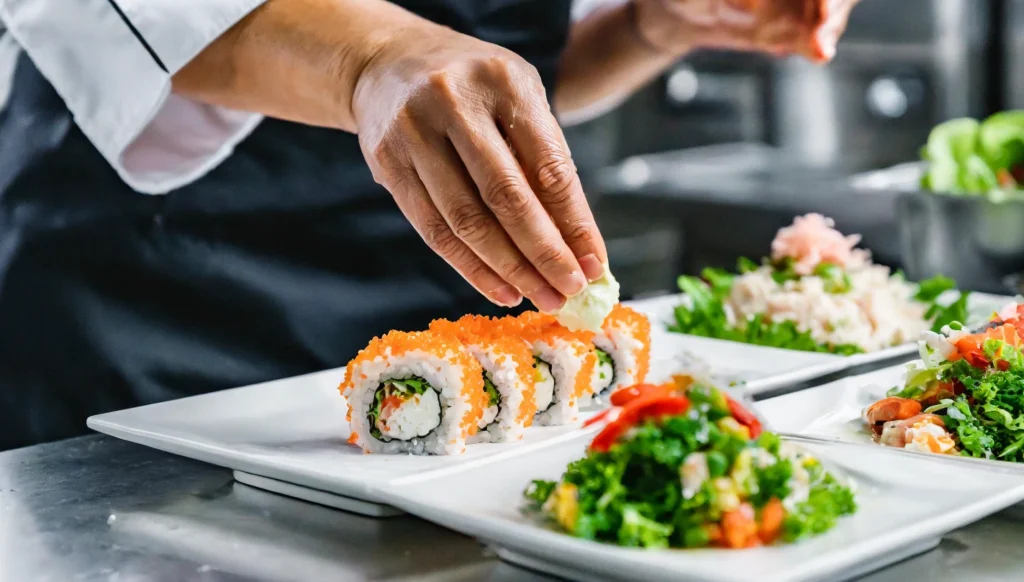
Introduction to Imitation Crab
Imitation crab, also known as “krab” or “crab sticks,” is a type of seafood made from surimi, a fish paste processed to mimic the texture and taste of crab meat. Popular in various dishes such as seafood salads, crab cakes, and sushi rolls, imitation crab is an affordable alternative to real crab. But the question remains, Is it healthy to eat imitation crab meat?
Composition of Imitation Crab
Imitation crab is primarily made from surimi, which involves the following ingredients:
- Fish Flesh: Typically pollock, which is deboned, washed, and minced.
- Water: Used to achieve the desired texture and maintain cost efficiency.
- Starches: Such as potato, wheat, corn, or tapioca to help bind and stabilize the mixture.
- Egg Whites or Other Proteins: To improve texture and enhance protein content.
- Sugars and Sorbitol: These add a touch of sweetness and assist with the freezing process.
- Vegetable Oils: Like sunflower or soybean oil, to enhance texture and color.
- Salt and Seasonings: For flavor and to help in the binding process.
The surimi is then flavored, colored, and formed into products that look similar to crab meat. While this process makes imitation crab accessible and convenient, it also introduces various additives and preservatives which may impact its nutritional value.
Nutritional Comparison: Imitation Crab vs. Real Crab
When comparing imitation crab to real crab, several nutritional differences are notable:
- Caloric Content: Both have similar calorie counts, but the composition is different. Imitation crab is higher in carbohydrates, while real crab offers more protein and negligible carbs.
- Vitamins and Minerals: Real crab is a richer source of vitamin B12, zinc, and selenium.
- Omega-3 Fatty Acids: Real crab contains more omega-3 fatty acids, beneficial for heart health.
Given these differences, real crab tends to be a healthier option, particularly for those on low-carb diets or requiring higher nutrient intakes.

Learn more about seafood labeling regulations to better understand what you are consuming when it comes to imitation crab.
This section provides a foundational understanding of what imitation crab is and how it compares nutritionally to real crab, setting the stage for deeper exploration into its health implications and uses in cuisine. For more insights into seafood preparation, consider exploring other Imitation Crab recipes and seafood dishes on Daily Recipe Haven to enrich your culinary knowledge.
Health Considerations and Culinary Uses
Health Implications of Eating Imitation Crab
While imitation crab serves as a convenient and cost-effective alternative to real crab, there are health considerations to take into account:
- Additives and Preservatives: Common additives include:
- Carrageenan and xanthan gum for texture and stability.
- Monosodium glutamate (MSG) and disodium inosinate for enhanced flavor.
- Carmine and artificial colors to achieve the characteristic red color.
- Health Concerns: Some individuals may experience adverse reactions to additives like MSG, which has been associated with symptoms like headaches in sensitive individuals. Carrageenan has been linked to digestive issues in some animal studies.
- Allergens: Imitation crab often contains allergens such as wheat (gluten) and egg, making it unsuitable for those with allergies to these ingredients.
Given these factors, while imitation crab can be part of a varied diet, it is important to consider these potential health risks, especially for those with specific dietary restrictions or allergies.
Environmental and Ethical Concerns
The production of imitation crab also raises several environmental and ethical concerns:
- Overfishing: The primary fish used in surimi (typically pollock) can be subject to overfishing, affecting marine biodiversity.
- Habitat Damage: Fishing methods can damage marine habitats, impacting numerous aquatic species.
- Mislabeling: There is an ongoing issue with mislabeling in the seafood industry, which can mislead consumers about the sustainability and origins of the fish used.
These factors highlight the importance of choosing seafood products that are certified for sustainable practices, ensuring that environmental impacts are minimized. For more information on sustainable fishing practices, consider visiting National Oceanic and Atmospheric Administration’s website.
Culinary Applications of Imitation Crab

Despite the health and environmental concerns, imitation crab is versatile in the kitchen. It can be used in a variety of dishes:
- Cold Dishes: Salads, sushi rolls, and appetizers.
- Cooked Dishes: Stir-fries, casseroles, and soups. Here are some common ways to incorporate imitation crab into meals:
- Salads: Flake-style imitation crab can be mixed into a seafood salad.
- Sushi: Imitation crab sticks are a staple in California rolls.
- Hot Dishes: It can be added to pasta dishes or used as a filling in crab cakes.
Recipes featuring imitation crab can often be found on manufacturers’ websites or culinary sites like Daily Recipe Haven, where you can explore various uses and preparations of imitation crab.

Consumer Considerations
When choosing imitation crab, consumers should be mindful of:
- Price vs. Quality: While more affordable than real crab, the nutritional and culinary quality is generally lower.
- Labeling: Understanding labels can help avoid unwanted additives and allergens.
- Dietary Needs: It’s important for consumers with specific dietary needs or health considerations to read labels carefully to ensure that imitation crab fits into their diet.
Conclusion
While Is it healthy to eat imitation crab meat? may not yield a straightforward answer, it’s clear that it can be part of a balanced diet when consumed in moderation and chosen carefully with an eye on labels and sourcing. As with many processed foods, the key is to balance consumption with fresher, less processed options to maintain a healthy and varied diet.
Whether you’re exploring the health implications or the culinary versatility of imitation crab, informed choices are essential. To enhance your understanding and culinary skills, exploring internal links such as those for other seafood recipes and tips on Daily Recipe Haven can provide further insights and inspiration.
